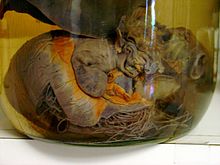Heartworm
| Dirofilaria immitis | |
|---|---|
 |
|
| A German Shepherd dog heart infested with Dirofilaria immitis | |
| Scientific classification | |
| Kingdom: | Animalia |
| Phylum: | Nematoda |
| Class: | Secernentea |
| Order: | Spirurida |
| Family: | Onchocercidae |
| Genus: | Dirofilaria |
| Species: | D. immitis |
| Binomial name | |
|
Dirofilaria immitis (Leidy, 1856) |
|
Dirofilaria immitis, the heartworm or dog heartworm, is a parasitic roundworm that is spread from host to host through the bites of mosquitoes. The heartworm is a type of filarial worm, a small thread-like worm, that causes filariasis. The definitive host is the dog, but it can also infect cats, wolves, coyotes, foxes, and other animals, such as ferrets, sea lions and even, under very rare circumstances, humans. The parasite is commonly called "heartworm"; however, adults often reside in the pulmonary arterial system (lung arteries), as well as the heart, and a major effect on the health for the animal is a manifestation of damage to the lung vessels and tissues. Occasionally, adult heartworms migrate to the right heart and even the great veins in heavy infections. Heartworm infection may result in serious disease for the host, with death typically as the result of congestive heart failure.
Although at one time confined to the southern United States, heartworm has now spread to nearly all locations where its vector, the mosquito, is found. Transmission of the parasite occurs in all of the United States (cases have even been reported in Alaska), and the warmer regions of Canada. The highest infection rates are found within 150 miles of the coast from Texas to New Jersey, and along the Mississippi River and its major tributaries. It has also been found in South America, southern Europe,Southeast Asia, the Middle East,Australia, Korea, and Japan.
...
Wikipedia
